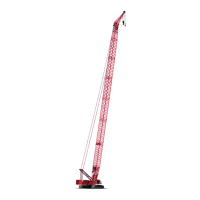INTRODUCTION 16000 SERVICE/MAINTENANCE MANUAL
1-14
Published 05-09-17, Control # 014-28
Hydraulic Components
High-pressure piston pumps driven by a multi-pump drive
transmission provide independent closed-loop hydraulic
power for crane functions. Each system has relief valves to
protect for overload or shock.
Hydraulic Tank
The hydraulic tank has two sections separated by a baffle; a
suction section and a return section. Hydraulic tank
components include a separate breather, suction strainer,
return filters, diffuser, temperature sensor, level sensor, and
pressure ports.
The suction section has a 100 micron, 200 mesh strainer that
allows fluid bypass around the strainer at 3 psi (0,21 bar) if it
becomes plugged. The breather protects the tank from
excessive pressures or vacuum opening at 1.5 in of mercury
(38 mm HG).
A system fault alarm indicates when hydraulic tank fluid level
is low, hydraulic fluid temperature is too high, or there is filter
blockage.
Tank hydraulic strainers and filters remove contaminants
from fluid. System filtration does not transform deteriorated
fluid into purified quality fluid. A program to test or replace
hydraulic fluid at scheduled times must be established for
efficient operation of all hydraulic systems.
Shut-off Valve
A hydraulic shut-off valve is located between tank and
suction manifold. Close this shut-off valve when performing
maintenance on hydraulic systems. Open shut-off valve
before starting engine.
Supercharge Manifold
Supercharge manifold supplies fluid to all system pumps.
When shut-off valve is open, fluid flows from tank to
supercharge pump through suction manifold. Supercharge
pump supplies hydraulic fluid to supercharge filter manifold.
Charge filters must be changed when system fault alarm is
enabled and fault display indicates that filters need to be
serviced. Starting with 16001142, charge filters not present.
Return Manifolds
Return fluid from motor and pump case drains is routed
through main return manifold and cooler before entering
hydraulic tank. Main return manifold has a 25 psi (1,7 bar)
bypass that allows fluid to bypass cooler if it becomes
plugged. Return fluid from relief valves, brake valves, drum
pawls, and counterbalance pin cylinders returns to other
return manifold, bypassing cooler before entering tank.
Hydraulic Fluid Cooler
If hydraulic fluid temperature is above 140°F (60°C), fluid
flows through cooler before returning to tank. Hydraulic fluid
bypasses cooler if below above temperature.
Supercharge Pump(s/n 16001141 and prior)
The supercharge pump is a fixed displacement gear pump
that draws hydraulic fluid from suction manifold and supplies
make-up hydraulic fluid to supercharge manifold.
Accessory/MAX-ER Pump
The accessory/MAX-ER pump is a variable displacement
piston pump that draws hydraulic fluid from suction manifold
and supplies hydraulic fluid to high and low pressure
accessories and the optional MAX-ER attachment.
Hydraulic Pumps
See hydraulic pump manufacturer’s Service Manual for a
complete description of a hydraulic piston pump.
Drum, swing, and travel pumps are variable displacement,
axial piston pumps that operate in a bi-directional closed-
loop system
.
Each pump contains:
• Charge pump
• EDC (Electrical Displacement Control)
• Cylinder block where pistons are positioned axially
around a drive shaft
• Charge pressure relief valve
• Two multifunction (relief) valves
Each system pump has a gerotor type gear charge pump
that is internally mounted on the end of each pump system
drive shaft. System charge pump draws fluid directly from
supercharge manifold and delivers it to closed-loop system
at a charge pressure of approximately at 350 psi (24 bar).
Charge pressure depends on engine load/speed, pressure
relief valve settings, and hydraulic system efficiency.
When a system control handle is moved, a node controller
sends a variable 0 to 24 volt output to pump EDC as required
for handle command direction. Pump EDC tilts swashplate to
stroke pump in the command direction. Pump pistons move
within cylinder block as the block rotates. The longer stroke
of each piston draws in return fluid from system motor. As the
stroke shortens, hydraulic fluid is pushed out of pump piston
cylinders into hydraulic piping to the motor. Pressurized
hydraulic fluid from the pump turns the motor in the

